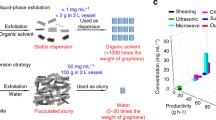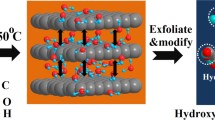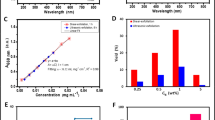Abstract
Graphene nanosheets prepared by liquid-phase exfoliation tend to aggregate easily and irreversibly in most solvents due to van der Waals forces and high surface energy. This article presents a facile, low-cost and novel approach for the preservation and separation of graphene dispersions by adjusting the temperature and solvent. Using IPA-water mixtures can realize green production of graphene nanosheets, and different physicochemical parameters are achievable by changing the proportion of components. Two valid methods for improving stability were discussed in depth: low-temperature storage as a liquid and as a solid. When graphene dispersions are stored in a liquid phase, agglomeration of nanosheets in mixed solvents can be effectively retarded by strong viscous resistance induced by low temperatures. Frozen powder prepared by liquid nitrogen maintains the nanosheets in a dispersed state and is suitable for long-term preservation in the solid phase in ordinary freezers. Furthermore, rapid separation of graphene nanosheets is a challenging problem that retards industrial production. Flocculation induced by slow freezing can accelerate solid–liquid separation, offering a novel approach to obtain easily dispersed powders. Various patterns could be printed on paper and poly(ethylene terephthalate) by a simple and low-cost screen printing technique using the graphene powder, providing a new platform for scalable, low-cost printing of electronics. Consequently, this scalable and simple strategy can be satisfactorily applied to the preservation and separation of graphene and is expected to extend to other nanomaterials, including MoS2 and h-BN.





Similar content being viewed by others
References
Allen MJ, Tung VC, Kaner RB (2009) Honeycomb carbon: a review of graphene. Chem Rev 110:132–145
Geim AK, Novoselov KS (2007) The rise of graphene. Nat Mater 6:183–191
Edwards RS, Coleman KS (2013) Graphene synthesis: relationship to applications. Nanoscale 5:38–51
Brownson DAC, Varey SA, Hussain F et al (2014) Electrochemical properties of CVD grown pristine graphene: monolayer- vs. quasi-graphene. Nanoscale 6:1607–1621
Antonova IV, Basyleva EV, Kotin IA (2017) High carrier mobility in quasi-suspended few-layer graphene on printed graphene oxide layers. J Mater Sci 52:10230–10236. https://doi.org/10.1007/s10853-017-1186-3
Jia X, Campos-Delgado J, Terrones M et al (2011) Graphene edges: a review of their fabrication and characterization. Nanoscale 3:86–95
Abdelkader AM, Cooper AJ, Dryfe RAW et al (2015) How to get between the sheets: a review of recent works on the electrochemical exfoliation of graphene materials from bulk graphite. Nanoscale 7:6944–6956
Fang W, Hsu AL, Song Y et al (2015) A review of large-area bilayer graphene synthesis by chemical vapor deposition. Nanoscale 7:20335–20351
Wu W, Zhang C, Hou S (2017) Electrochemical exfoliation of graphene and graphene-analogous 2D nanosheets. J Mater Sci 52:10649–10660. https://doi.org/10.1007/s10853-017-1289-x
Hernandez Y, Nicolosi V, Lotya M et al (2008) High-yield production of graphene by liquid-phase exfoliation of graphite. Nat Nanotechnol 3:563–568
Liu L, Shen Z, Yi M et al (2014) A green, rapid and size-controlled production of high-quality graphene sheets by hydrodynamic forces. RSC Adv 4:36464–36470
Choi W, Lahiri I, Seelaboyina R et al (2010) Synthesis of graphene and its applications: a review. Crit Rev Solid State Mater Sci 35:52–71
Wei D, Kivioja J (2013) Graphene for energy solutions and its industrialization. Nanoscale 5:10108–10126
Liu L, Shen Z, Liang S et al (2014) Graphene for reducing bubble defects and enhancing mechanical properties of graphene/cellulose acetate composite films. J Mater Sci 49:321–328. https://doi.org/10.1007/s10853-013-7708-8
Ciesielski A, Samori P (2014) Graphene via sonication assisted liquid-phase exfoliation. Chem Soc Rev 43:381–398
Si Y, Samulski ET (2008) Synthesis of water soluble graphene. Nano Lett 8:1679–1682
Wu Z, Liu J, Li Y et al (2015) Self-assembly of nanoclusters into Mono-Few-, and multilayered sheets via dipole-induced asymmetric van der waals attraction. ACS Nano 9:6315–6323
Lee YJ, Huang L, Wang H et al (2015) Structural rearrangement and dispersion of functionalized graphene sheets in aqueous solutions. Colloids Interface Sci Commun 8:1–5
Su Y, Yang G, Lu K et al (2017) Colloidal properties and stability of aqueous suspensions of few-layer graphene: importance of graphene concentration. Environ Pollut 220:469–477
Texter J (2014) Graphene dispersions. Curr Opin Colloid Interface Sci 19:163–174
Liu J, Tang J, Gooding JJ (2012) Strategies for chemical modification of graphene and applications of chemically modified graphene. J Mater Chem 22:12435–12452
Lin Y, Jin J, Song M (2011) Preparation and characterisation of covalent polymer functionalized graphene oxide. J Mater Chem 21:3455–3461
Shen Z, Li J, Yi M et al (2011) Preparation of graphene by jet cavitation. Nanotechnology 22:365306
Hernandez Y, Lotya M, Rickard D et al (2010) Measurement of multicomponent solubility parameters for graphene facilitates solvent discovery. Langmuir 26:3208–3213
Hernandez Y, Nicolosi V, Lotya M et al (2008) High-yield production of graphene by liquid-phase exfoliation of graphite. Nat Nanotechnol 3:563–568
Zhou KG, Mao NN, Wang HX et al (2011) A mixed-solvent strategy for efficient exfoliation of inorganic graphene analogues. Angew Chem Int Ed 50:10839–10842
Yi M, Shen Z, Ma S et al (2012) A mixed-solvent strategy for facile and green preparation of graphene by liquid-phase exfoliation of graphite. J Nanopart Res 14:1–9
Shen ZG, Li JZ, Yi M et al (2011) Preparation of graphene by jet cavitation. Nanotechnology 22:365306
Ibrahem MA, T-w Lan, Huang JK et al (2013) High quantity and quality few-layers transition metal disulfide nanosheets from wet-milling exfoliation. RSC Adv 3:13193–13202
Kudin KN, Ozbas B, Schniepp HC et al (2008) Raman spectra of graphite oxide and functionalized graphene sheets. Nano Lett 8:36–41
O’Neill A, Khan U, Nirmalraj PN et al (2011) Graphene dispersion and exfoliation in low boiling point solvents. J Phys Chem C 115:5422–5428
Hansen CM (2012) Hansen solubility parameters: a user’s handbook. CRC Press, Boca Raton
Hong J-Y, Jang J (2012) Highly stable, concentrated dispersions of graphene oxide sheets and their electro-responsive characteristics. Soft Matter 8:7348–7350
Walter J, Nacken TJ, Damm C et al (2015) Graphene oxide: determination of the lateral dimension of graphene oxide nanosheets using analytical ultracentrifugation (small 7/2015). Small 11:814–825
Silvera Batista CA, Zheng M, Khripin CY et al (2014) Rod hydrodynamics and length distributions of single-wall carbon nanotubes using analytical ultracentrifugation. Langmuir 30:4895–4904
Tirado MM, Martínez CL, Torre JG (1984) Comparison of theories for the translational and rotational diffusion coefficients of rod-like macromolecules. Application to short DNA fragments. J Chem Phys 81:2047–2052
Steinberger R (1999) Chemical properties handbook. World Pub. Co., Beijing
Seeton CJ (2006) Viscosity–temperature correlation for liquids. Tribol Lett 22:67–78
Aladko L, Manakov AY, Ogienko A et al (2009) New data on phase diagram and clathrate formation in the system water–isopropyl alcohol. J Incl Phenom Macrocycl Chem 63:151–157
Chen Z, Ren W, Gao L et al (2011) Three-dimensional flexible and conductive interconnected graphene networks grown by chemical vapour deposition. Nat Mater 10:424
Hong J-Y, Yun S, Wie JJ et al (2016) Cartilage-inspired superelastic ultradurable graphene aerogels prepared by the selective gluing of intersheet joints. Nanoscale 8:12900–12909
Acknowledgements
This work was supported by the Specialized Research Fund for the Doctoral Program of Higher Education (Grant Number 20131102110016) and the China Postdoctoral Science Foundation (Grant Number 157212).
Author information
Authors and Affiliations
Corresponding author
Electronic supplementary material
Below is the link to the electronic supplementary material.
Rights and permissions
About this article
Cite this article
Liu, L., Shen, Z., Zhang, X. et al. Low-temperature treatment for preservation and separation of graphene dispersions. J Mater Sci 53, 13875–13885 (2018). https://doi.org/10.1007/s10853-018-2572-1
Received:
Accepted:
Published:
Issue Date:
DOI: https://doi.org/10.1007/s10853-018-2572-1




